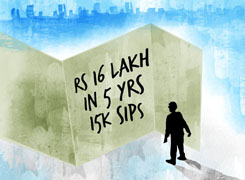Ramalingam Kalirajan |10872 Answers |Ask -Follow
Mutual Funds, Financial Planning Expert - Answered on May 20, 2024
He has an MBA in finance from the University of Madras and is a certified financial planner.
He is the director and chief financial planner at Holistic Investment, a Chennai-based firm that offers financial planning and wealth management advice.... more

Hello Sir. I work in a private company. I m 49. Will retire in next 5 years. My SIP since last 4 years is 15000 pm. Increased to 22500 last year. Break up.is ICICI prudential blue chip 5000 Mirrae assets - 7500 Kotal Small cap - 7500 I also invest 12,500 p.m in PPF for taxation purpose. I would like to increase 10000 rs more in SIP, which SIP should I invest in
Assessing Your Portfolio
Your current portfolio is diversified across large-cap, multi-cap, and small-cap funds. This balance provides a good mix of stability and growth potential. As you are planning to retire in the next five years, a careful assessment of risk and return is crucial.
Portfolio Diversification
Large-Cap Fund (ICICI Prudential Blue Chip): Provides stability and steady returns. Large-cap funds invest in well-established companies with a history of reliable performance.
Multi-Cap Fund (Mirae Asset): Offers exposure to companies of various sizes, balancing growth potential with risk.
Small-Cap Fund (Kotak Small Cap): Targets high growth but comes with higher volatility and risk. Small-cap funds can provide significant returns over time.
Public Provident Fund (PPF)
Your PPF contributions are beneficial for tax savings and offer secure returns. PPF is a good debt investment, providing a counterbalance to the equity risk in your portfolio.
Increasing Your SIP by ?10,000
You plan to increase your SIP by ?10,000 per month. Here’s a strategic approach:
Adding Mid-Cap and Balanced Funds
Mid-Cap Fund: Consider investing in a mid-cap fund. These funds invest in mid-sized companies, offering a balance between large-cap stability and small-cap growth.
Balanced Fund: Balanced funds invest in both equities and debt instruments. They offer moderate risk and steady returns, suitable for someone nearing retirement.
Benefits of Actively Managed Funds
Professional Management: Actively managed funds are overseen by fund managers who make strategic investment decisions. This can potentially lead to better performance than index funds.
Market Adaptability: These funds can adapt to market changes, optimizing returns and managing risks effectively.
Disadvantages of Direct Funds
Higher Effort: Direct funds require you to make investment decisions and manage the portfolio yourself. This can be time-consuming and challenging.
Professional Guidance: Investing through a Certified Financial Planner (CFP) ensures professional management and strategic alignment with your financial goals.
Implementing the New Investment Plan
Step-by-Step Approach
Assess Your Risk Tolerance: Given your retirement timeline, it's crucial to balance risk and return. Consider how much risk you are comfortable taking.
Allocate the New SIP Amount: Invest ?5,000 in a mid-cap fund and ?5,000 in a balanced fund. This diversification enhances your portfolio's growth potential while maintaining stability.
Regular Monitoring: Review your portfolio regularly. A CFP can help you adjust your investments based on market conditions and changing financial goals.
Professional Guidance
Engaging with a CFP provides several advantages:
Tailored Advice: A CFP can offer investment advice tailored to your specific situation, risk tolerance, and retirement goals.
Portfolio Management: Regular monitoring and rebalancing ensure your investments stay aligned with your financial objectives.
Conclusion
Increasing your SIP by ?10,000 and diversifying into mid-cap and balanced funds will enhance your portfolio. Regular reviews with a CFP ensure your investments align with your retirement goals.
Best Regards,
K. Ramalingam, MBA, CFP,
Chief Financial Planner,
www.holisticinvestment.in
You may like to see similar questions and answers below
Ramalingam Kalirajan |10872 Answers |Ask -Follow
Mutual Funds, Financial Planning Expert - Answered on Apr 30, 2024
Sanjeev Govila | Answer |Ask -Follow
Financial Planner - Answered on Feb 06, 2024
Ramalingam Kalirajan |10872 Answers |Ask -Follow
Mutual Funds, Financial Planning Expert - Answered on Jul 16, 2024
Ramalingam Kalirajan |10872 Answers |Ask -Follow
Mutual Funds, Financial Planning Expert - Answered on Jan 29, 2025
Ramalingam Kalirajan |10872 Answers |Ask -Follow
Mutual Funds, Financial Planning Expert - Answered on Jul 09, 2025
Radheshyam Zanwar |6735 Answers |Ask -Follow
MHT-CET, IIT-JEE, NEET-UG Expert - Answered on Dec 06, 2025
Dr Nagarajan J S K |2576 Answers |Ask -Follow
NEET, Medical, Pharmacy Careers - Answered on Dec 06, 2025
Mihir Tanna |1090 Answers |Ask -Follow
Tax Expert - Answered on Dec 06, 2025
Ramalingam Kalirajan |10872 Answers |Ask -Follow
Mutual Funds, Financial Planning Expert - Answered on Dec 06, 2025
Radheshyam Zanwar |6735 Answers |Ask -Follow
MHT-CET, IIT-JEE, NEET-UG Expert - Answered on Dec 06, 2025
Radheshyam Zanwar |6735 Answers |Ask -Follow
MHT-CET, IIT-JEE, NEET-UG Expert - Answered on Dec 06, 2025
Radheshyam Zanwar |6735 Answers |Ask -Follow
MHT-CET, IIT-JEE, NEET-UG Expert - Answered on Dec 06, 2025
Dr Dipankar Dutta |1837 Answers |Ask -Follow
Tech Careers and Skill Development Expert - Answered on Dec 05, 2025
Dr Shyam Jamalabad |108 Answers |Ask -Follow
Dentist - Answered on Dec 05, 2025
Dr Shyam Jamalabad |108 Answers |Ask -Follow
Dentist - Answered on Dec 05, 2025



























